Physical Address
304 North Cardinal St.
Dorchester Center, MA 02124
Hydrocephalus is defined as disturbances in cerebrospinal fluid dynamics.
Acute hydrocephalus and shunt obstruction are neurosurgical emergencies.
Cerebrospinal fluid drainage shunts are the main treatment option of hydrocephalus. However, shunt complications are relatively common.
Endoscopic third ventriculostomy is an alternative treatment option in patients with obstructive hydrocephalus.
The term hydrocephalus is a modern Latin adaptation from Greek hudrokephalon, from húdōr (“water”) + kephalē (“head”). Hydrocephalus is not a single disease entity. It is rather a spectrum of conditions where there is a disturbance in cerebrospinal fluid (CSF) dynamics.
The practice of hydrocephalus in adults is different from that of pediatrics. It involves managing patients with newly developed high-pressure hydrocephalus of various etiologies. A significant proportion involves patients with normal/low-pressure hydrocephalic conditions, such as normal pressure hydrocephalus (NPH), or long-standing overt ventriculomegaly in adults (LOVA). It also includes caring for patients transiting from pediatrics practice to adult practice with hydrocephalus treated during childhood. Although not strictly a hydrocephalus condition, idiopathic intracranial hypertension (IIH) is often managed as part of the adult hydrocephalus practice.
Cerebral ventricles are four interconnected cavities of the brain lined by ependymal cells and filled by the cerebrospinal fluid, a clear, colorless fluid that also surrounds the brain, spinal cord, and cauda equina. CSF is not a filtrate of the blood. It is produced by active secretion mainly at the choroid plexuses of the cerebral ventricles. It is formed at a rate of about 0.35 mL/min. The daily volume of CSF produced in adult humans is about 500 mL. Total CSF space in young adults is about 150 mL—that is, CSF is totally replaced about four times each day. Only about 25% of CSF volume lies within the ventricles. The rest resides in the cranial and spinal subarachnoid space.
CSF circulates from the two lateral ventricles, through the interventricular foramen of Monro to the third ventricle, then through the cerebral aqueduct of Sylvius to the fourth ventricle. From the fourth ventricle, CSF passes to the subarachnoid space around the brain and spinal cord through the foramen of Magendie in the midline and the two foramina of Luschka laterally ( Fig. 60.1 ). The CSF circulation comprises not only a directed flow of CSF but a pulsatile to-and-fro movement as well. It was thought that the dural venous sinus's arachnoid villi and granulations play an important role in CSF absorption. However, research has disputed that theory. The currently accepted theory is that CSF is cleared by bulk flow along sleeves of the subarachnoid space surrounding the olfactory and optic nerves as well as spinal nerve roots.
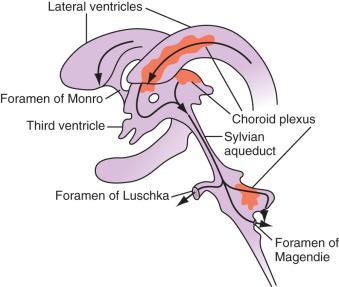
CSF functions include protection of the brain acting as a cushion that lessens the impact of a blow. By keeping the brain buoyant, the net weight of the brain is reduced from about 1400 gm to about 50 gm, thereby eliminating pressure on the base of the brain and the important basal cerebral arteries. CSF also serves as a medium to transport hormones to other areas of the brain. CSF circulates around blood vessels penetrating from the subarachnoid space into the Virchow-Robin spaces. We are starting to understand that the clearance of waste products from the brain during sleep may depend on CSF circulation as part of the glymphatic system.
The relationship between intracranial components' volume and intracranial pressure is important in the pathophysiology of many hydrocephalic syndromes. The Monro-Kellie doctrine states that the skull is a closed bony box with constant volume. An increase in volume of one of the cranial constituents, or the presence of a mass lesion (tumor or hematoma), would result in raised intracranial pressure (ICP).
A physiologic buffer exists, where some compensation is possible as cerebrospinal fluid CSF and blood move into the spinal canal and extracranial vasculature, respectively. Beyond this point, ICP rises dramatically ( Fig. 60.2 ). Increased ICP can lead to one of the life-threatening herniation syndromes (coning).
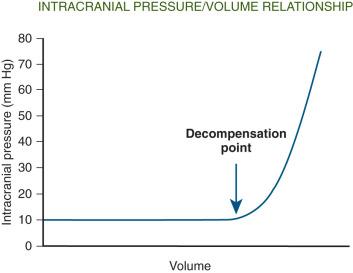
The widely accepted value of normal ICP is 8 to 12 mm Hg in flat lateral position. This is derived from the CSF opening pressure on lumbar puncture done in flat lateral position. An important contributory factor to ICP is the CSF. Pressure is expected to be the same throughout the system (intracranial and spinal dural compartments) in supine position, but gravity will give rise to hydrostatic pressure gradients in upright or seated positions. Humans are upright most of the time. Normal ICP is thought to be negative in upright or seated positions. It is thought that CSF and ICP change in relation to posture change could be also influenced by posture-related change in intraabdominal or dural venous sinus pressures, which are, in turn, related to intrathoracic and spinal epidural venous plexus pressure.
There are different classification schemes of the hydrocephalic conditions. A widely used classification is based on CSF dynamics, where hydrocephalus is classified as obstructive (noncommunicating) or nonobstructive (communicating) depending on the presence of a blockage of CSF circulation in the ventricular system or more distally at the subarachnoid space. This classification has clinical significance in relation to the safety of caudal CSF drainage; lumbar puncture is contraindicated in obstructive hydrocephalus. Hydrocephalus syndromes can also be classified based on age of onset as neonatal, infantile, pediatric, or adult hydrocephalus. Adult hydrocephalus is often subclassified as high or normal (low) pressure hydrocephalus.
The underlying causes of hydrocephalus syndromes can be broadly classified into congenital, acquired, and idiopathic categories. Congenital hydrocephalus usually presents in the neonatal period. Chiari malformation (type 2) is commonly associated with myelomeningocele. Dandy-Walker complex is a specific entity with hydrocephalus caused by atresia of the foramina of Luschka and Magendie, with agenesis of cerebellar vermis ( Fig. 60.3 ). Aqueduct stenosis can present in adulthood as triventricular hydrocephalus: enlarged third and lateral ventricles with a small fourth ventricle ( Fig. 60.4A–B ). The underlying cause is either forking, septum, true stenosis, or gliosis of the aqueduct. An X-linked recessive gene is a rare cause of aqueduct stenosis.
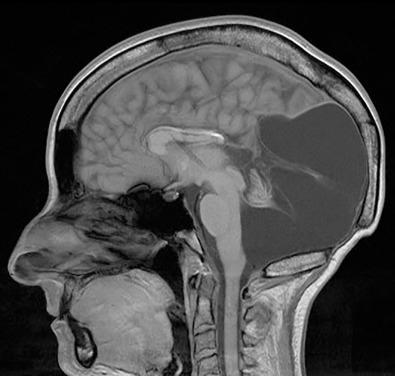
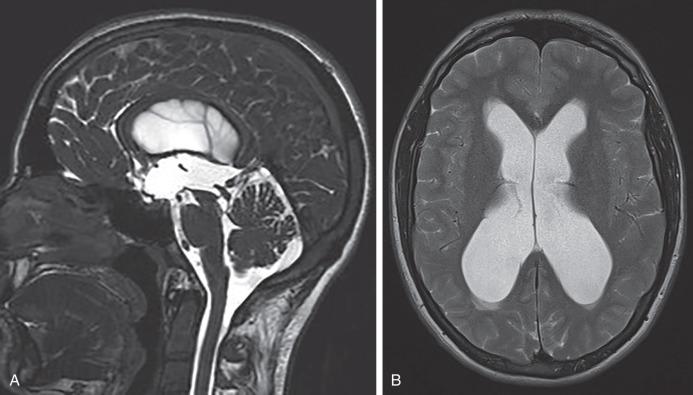
Acquired causes of hydrocephalus include hemorrhage, infection, or tumors. In adults, communicating hydrocephalus is a common complication of subarachnoid hemorrhage. Postmeningitis hydrocephalus is seen, as is postpyogenic or tuberculous meningitis.
Mass lesions including tumors blocking CSF pathways result in obstructive hydrocephalus ( Fig. 60.5A–C ). The first presentation of posterior fossa tumors (eg, astrocytoma or metastatic tumors) is often that of raised intracranial pressure caused by hydrocephalus. A colloid cyst of the third ventricle results in intermittent hydrocephalus or acute hydrocephalus. Pineal tumors cause aqueduct stenosis and triventricular hydrocephalus. Choroid plexus papillomas or carcinomas are rare entities that produce hydrocephalus by excessive CSF production.
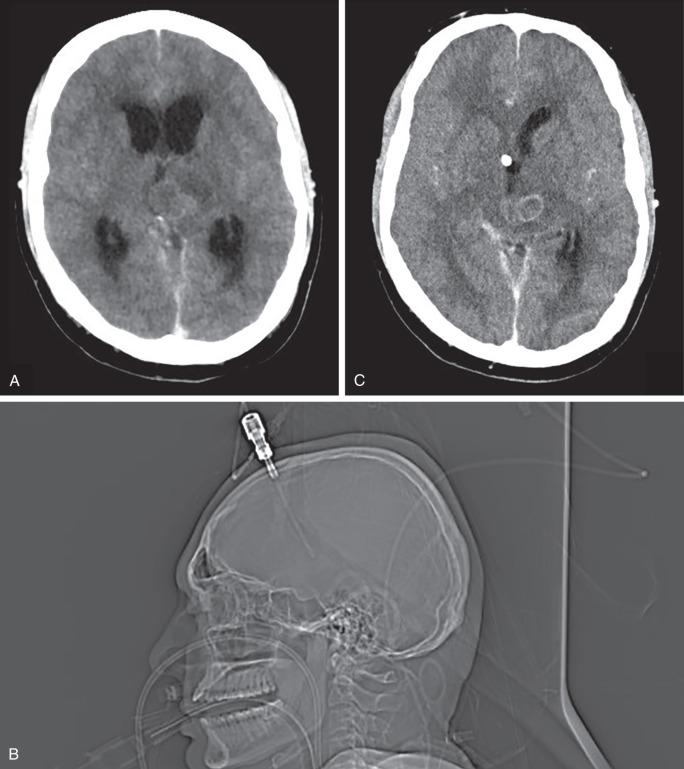
Normal pressure hydrocephalus is a disease of the elderly population. The underlying cause is not fully understood. It is thought that the chronic impairment of the Windkessel effect caused by cerebrovascular disease causes increased brain pulsation and compression of periventricular tissue producing ventriculomegaly, with possible stretching of periventricular white matter tracts and subependymal microvascular ischemia.
A large proportion of adult hydrocephalus patients represent those who had shunt insertion during childhood. The incidence of pediatric hydrocephalus is less than 1 in 1000 life births. In the developed countries, there has been a decline in hydrocephalus caused by congenital malformation or infection. On the other hand, the incidence of posthemorrhagic hydrocephalus in prematurely born infants has increased with improving survival rates.
Population-based studies estimate the prevalence of normal pressure hydrocephalus in the elderly population to be 1.4% to 2.9%, and the incidence has been estimated to be 5.5/100,000 per year. Several studies have estimated the prevalence of NPH in the dementia population to be between 1.6% and 5.4%.
The clinical presentation of hydrocephalus varies depending on the etiology. In adults, high-pressure hydrocephalus presents with features of raised intracranial pressure: Headache is classically worse in the morning (this is due to relative hypercapnia during sleep and subsequent vasodilation). Vomiting will often relieve the headache as a result of hyperventilation clearing CO 2 and hence improve intracranial pressure. Diplopia is caused by sixth nerve palsy resulting from distortion of this relatively long slender cranial nerve. Other symptoms include lethargy and behavioral disturbances. Signs include papilledema and sixth cranial nerve palsy. If untreated, impaired consciousness will follow. A further rise in intracranial pressure will result in brain herniation (coning). Impending coning is associated with hypertension, bradycardia, and irregular breathing. The patient will have decerebrate posture and start to have pupillary changes. Without urgent intervention, irreversible coning and death will follow within minutes.
NPH is a disease of the elderly population. It could be either idiopathic or secondary to brain hemorrhage, tumor, or previous trauma. The classical presentation of NPH is that of gait and balance impairment, cognitive impairment, and incontinence.
Impairment of gait is the most readily recognized feature of NPH. The pattern of gait seen in NPH patients has been variably described as apractic, glue footed, magnetic, parkinsonian, short stepped, and shuffling. Freezing is a common feature. Weakness of the legs is not usually evident on neurologic examination.
Increased frequency and urgency without actual urinary incontinence may be seen in early stages of the disorder. Progression to frank urinary incontinence usually occurs with disease progression.
The principal cognitive symptoms seen in idiopathic normal pressure hydrocephalus are suggestive of a subcortical process, mainly involving frontal lobe functions, such as attention, psychomotor speed, verbal fluency, and executive functions. Recognition memory and orientation are relatively preserved compared with Alzheimer disease.
LOVA is a form of hydrocephalus that is thought to develop during childhood (compensated hydrocephalus) and manifests symptoms during adulthood (decompensated hydrocephalus). Brain imaging reveals severe ventriculomegaly ( Fig. 60.6A–B ). Although symptoms and signs could be of high-pressure hydrocephalus, many LOVA patients present with symptoms of low-pressure hydrocephalus, in the form of dizziness, headache, cognitive impairment, gait disturbance, and urinary incontinence.
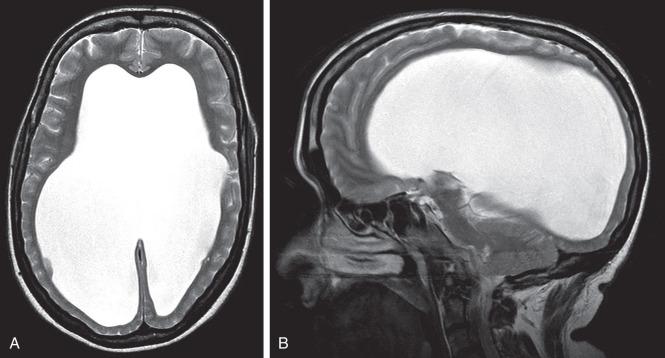
Any condition causing raised intracranial pressure could present in a similar way to hydrocephalus. The differential diagnosis includes brain tumors, cerebral abscess, intracranial hemorrhage, migraines, and idiopathic intracranial hypertension.
Because NPH is a disease of the elderly population, where gait difficulties, dementia, and urinary incontinence are common, the differential diagnosis includes a wide range of conditions:
Disorders affecting gait may occur, such as peripheral neuropathy, cervical or lumbar stenosis, arthritis, vestibular diseases, and Parkinson disease.
The cognitive impairment observed in NPH has some similarity to other subcortical dementias, including Parkinson disease, diffuse Lewy body disease, and vascular dementia. The absence of apraxia, agnosia, and aphasia can help differentiate NPH from cortical dementias, like Alzheimer disease.
Urinary symptoms might be caused by prostate disease in men or chronic urinary tract infections in women.
Neuroimaging is essential to diagnose hydrocephalus. A computed tomography (CT) scan of the brain is the main investigation method in emergency situations. It can be done quickly and gives useful information with regard to ventricular size, the presence of hemorrhage or calcifications, or intracranial mass lesions. Contrast administration is useful in the differential diagnosis of such lesions.
Radiologic features of hydrocephalus include features of ventriculomegaly, ballooning of the frontal horns and third ventricle, temporal horns greater than 2 mm in size, periventricular edema, crowded cerebral sulci, and Evans index (the ratio of the frontal horns to the greater biparietal diameter) greater than 0.3.
The main drawback of CT scan is that of radiation exposure. Hydrocephalus is a chronic condition, and patients are likely to need multiple images over their lifetime. Accordingly, MRI scan should be used as an alternative in nonemergency situations. MRI has greater spatial resolution and has multiplanar projections, thus could help in delineating an underlying lesion. MRI CSF flow studies can help in assessing flow through different parts of the CSF circulation (eg, cerebral aqueduct).
Several imaging features have been found to be associated with positive response to shunt insertion in normal pressure hydrocephalus ( Fig. 60.7 ), particularly the presence of tight high-convexity and medial surface subarachnoid spaces with concomitant expanded Sylvian fissures (disproportionately enlarged subarachnoid-space hydrocephalus [DESH]). Other features include narrow callosal angle (the angle of the roof of the lateral ventricles measured on the coronal MRI of the posterior commissure perpendicular to the anteroposterior commissure plane) and focal impingement and thinning of corpus callosum.
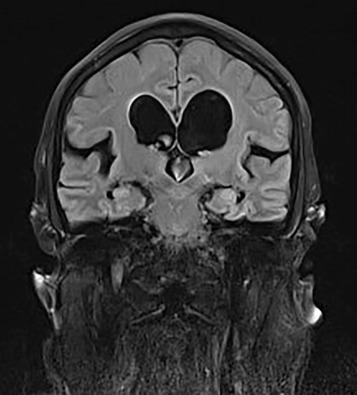
Become a Clinical Tree membership for Full access and enjoy Unlimited articles
If you are a member. Log in here